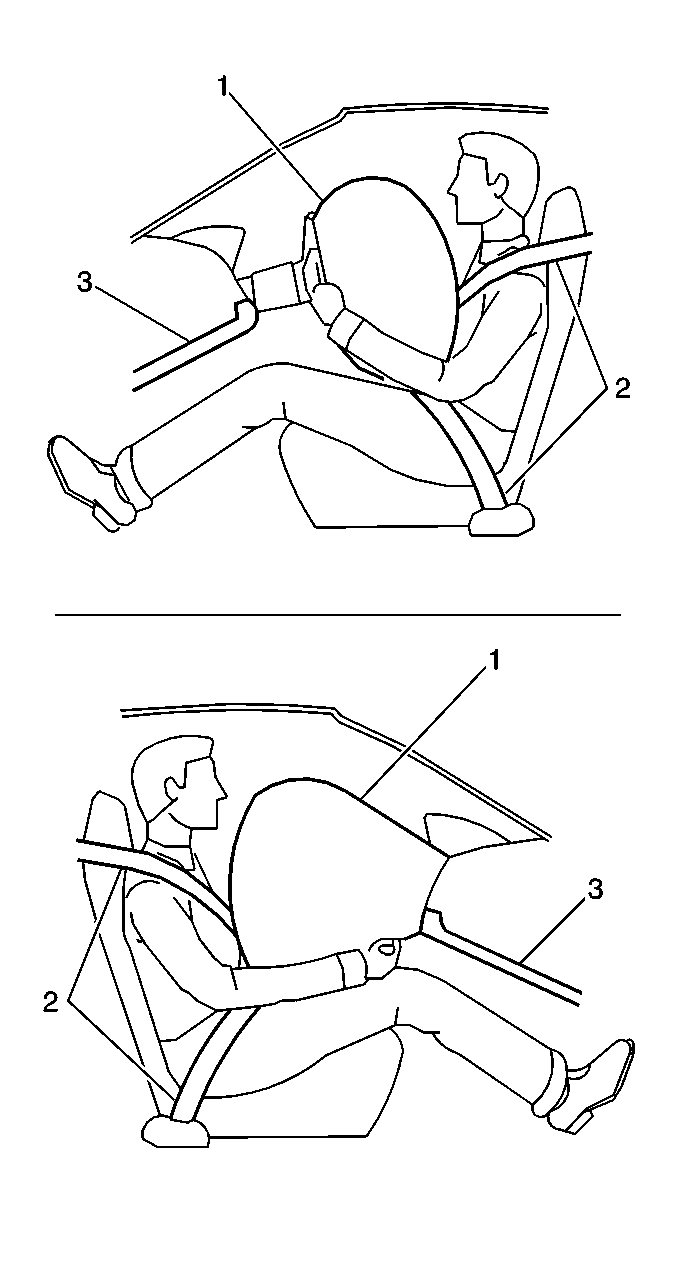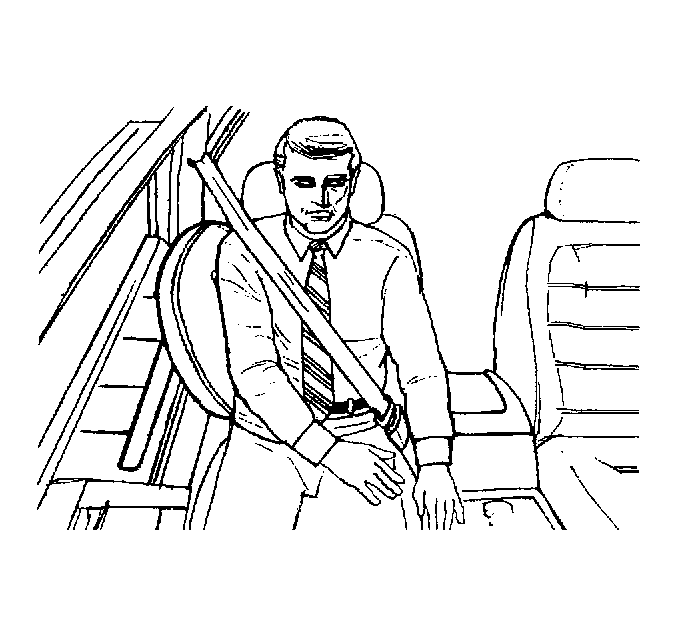SIR System Overview

The supplemental inflatable
restraint (SIR) system supplements the protection offered by the occupant's
seat belt system (2). The SIR system has various inflator modules located
throughout the vehicle, i.e. inflatable restraint steering wheel module
(1), inflatable restraint IP module (1), inflatable restraint side impact
module - LF, and the inflatable restraint side impact module - RF. In
addition to the inflator modules, the vehicle is equipped with seat belt
pretensioners that tighten the seat belt in the event of a collision, thus
reducing the distance between the occupant and the steering wheel or IP
when an inflator module is deployed. Each inflator module and seat belt
pretensioner has a deployment loop that is controlled by the inflatable
restraint sensing and diagnostic module (SDM). The SDM determines the
severity of a collision and commands deployment of each inflator module
and seat belt pretensioner. When the SDM detects a collision of sufficient
force, it will process the information to further support inflator module
and seat belt pretensioner deployment. The SDM performs continuous diagnostic
monitoring of the SIR system electrical components. Upon detection of a
circuit malfunction, the SDM will set a diagnostic trouble code (DTC) and
inform the driver by turning the AIR BAG indicator ON. The steering column
and the knee bolsters (3) are designed to absorb energy and compress during
frontal collisions in order to limit leg movement and decrease the chance
of injury to the driver and passenger.
Frontal SIR System
The SIR system consists of the following components:
| • | AIR BAG indicator located in the instrument panel cluster (IPC) |
| • | Driver and passenger knee bolsters |
| • | Inflatable restraint IP module |
| • | Inflatable restraint sensing and diagnostic module (SDM) |
| • | Inflatable restraint steering wheel module |
| • | Inflatable restraint steering wheel module coil |
| • | Inflatable restraint wiring harness |
| • | Seat belt pretensioner - LF |
| • | Seat belt pretensioner - RF |
| • | Steering wheel and steering column |
A frontal collision of sufficient force will deploy the inflator modules
and the seat belt pretensioners. The SDM contains a sensing device (accelerometer)
that converts vehicle velocity changes to an electrical signal. The
SDM contains a microprocessor, which performs calculations using the
measured accelerations and compares these calculations to a value stored
in memory. When the generated calculations exceed the stored value, the
SDM will cause current to flow through the deployment loops, deploying
the inflator modules and the seat belt pretensioners. Once the inflator
modules are inflated, they quickly deflate through the vent holes and/or
the fabric. After the inflator modules have deployed, the SDM sets a
deployment commanded DTC and then turns the AIR BAG indicator ON. The
SDM, IP module, steering wheel module, steering wheel module coil, seat
belt pretensioner - LF, seat belt pretensioner - RF, and the connecting
wires make up the frontal deployment loops. The SDM continuously monitors
the deployment loops for malfunctions and turns the AIR BAG indicator
ON if a fault is detected.
Inflatable Restraint Sensing and Diagnostic Module (SDM)
The inflatable restraint sensing and diagnostic module (SDM) is a microprocessor
and the control center for the SIR system. The SDM contains internal sensors
along with external sensors, if equipped, mounted at various locations,
depending on vehicle. In the event of a collision, the SDM performs calculations
using the signals received from the internal and external sensors, if
equipped. The SDM compares the result of the calculations to values stored
in memory. When these calculations exceed the stored value, the SDM will
cause current to flow through the deployment loops, deploying the inflator
modules and the seat belt pretensioners. The SDM records the SIR system
status when a deployment occurs and turns the AIR BAG indicator ON. The
SDM performs continuous diagnostic monitoring of the SIR system electrical
components and circuitry when the ignition is ON. If the SDM detects
a malfunction, a DTC will be stored and the SDM will turn the AIR BAG
indicator ON. In the event that ignition 1 voltage is lost during
a collision, the SDM maintains a 36 volt loop reserve (36 VLR)
for deployment of the inflator modules and the seat belt pretensioners.
It is important to note, when disabling the SIR system for service or
rescue operations, to allow the 36 VLR to dissipate, which could
take up to 1 minute.
AIR BAG Indicator
The AIR BAG indicator, located in the IPC, is used to notify the driver
of the SIR system malfunctions. When the ignition is turned ON, the SDM is
supplied with ignition 1 voltage. The SDM flashes the AIR BAG indicator
seven times. While flashing the AIR BAG indicator, the SDM conducts tests
on all SIR system components and circuits. If no malfunctions are detected,
the SDM will turn the AIR BAG indicator OFF. The SDM provides continuous
monitoring of the inflator module and seat belt pretensioner circuits
by conducting a sequence of checks. If a malfunction is detected, the
SDM will store a diagnostic trouble code (DTC) and turn the AIR BAG indicator
ON. The presence of a SIR system malfunction could result in non-deployment
of the inflator modules or the seat belt pretensioners. The AIR BAG indicator
will remain ON until the malfunction has been repaired.
Inflator Modules
The inflator modules contain a housing, an inflatable air bag, the initiator,
a canister of gas generating materials, and in some cases, stored compressed
gas. The initiator is part of the inflator module deployment loop. When
the vehicle is involved in a collision of sufficient force, the SDM causes
current to flow through the deployment loops to the initiator. Current
passing through the initiator ignites the material in the canister
producing a rapid generation of gas and the release of compressed gas,
if present. The gas produced from this reaction rapidly inflates the
inflator module. Once the inflator module is inflated, it quickly deflates
through the vent holes and/or the fabric. Each inflator module is equipped
with a shorting bar that is located in the connector of the inflator
module. The shorting bar shorts the inflator modules circuitry to prevent
unwanted deployment of the inflator module when the connector is disconnected.
Inflatable Restraint Steering Wheel Module Coil
The steering wheel module coil is attached to the steering column and
is located under the steering wheel. The steering wheel module coil consists
of two or more current - carrying coils. The coils allow the rotation
of the steering wheel while maintaining continuous electrical contact
between the steering wheel module deployment loop and the steering wheel
module. Two coil wires are used for the steering wheel module deployment
loop. Additional coil wires are used for accessories that are attached
to the steering wheel, depending on the vehicle model. The steering
wheel module coil connector is located near the base of the steering
column. The connector contains a shorting bar that shorts the steering
wheel module coil deployment loop circuitry to prevent unwanted deployment
of the steering wheel module when the connector is disconnected.
Side SIR System

The side SIR system consists
of the following components:
| • | AIR BAG indicator in the instrument panel cluster (IPC) |
| • | Inflatable restraint sensing and diagnostic module (SDM) |
| • | Inflatable restraint side impact modules - LF/RF |
| • | Inflatable restraint side impact sensors (SIS) - LH/RH |
| • | Inflatable restraint wiring harnesses |
The side impact modules are located in the outside portion of the front
seat backs. The side impact modules contain a housing, inflatable air bag,
initiating device, and a canister of gas generating material. The initiator
is part of the side impact module deployment loop. When a side impact collision
of sufficient force occurs, the SIS detects the impact and sends a signal
to the SDM. The SDM compares the signal received from the SIS to a value
stored in memory. When the generated signal exceeds the stored value, the
SDM will cause current to flow through the side deployment loop, deploying
the side impact module. The SDM, side impact modules, and the connecting
wires makeup the side deployment loops. The SDM continuously monitors the
deployment loops for malfunctions and turns the AIR BAG indicator ON if
a fault is present. Each side impact module is equipped with a shorting
bar located in the connector of the module. The shorting bar shorts the
side impact module deployment loop circuitry to prevent unwanted deployment
of the inflator module when the connector is disconnected.
Inflatable Restraint Side Impact Sensor (SIS)
The side impact sensor (SIS) is a pressure sensitive device that is
used in the detection of side impact collisions. Each SIS is located within
the driver and passenger front doors. The SIS monitors pressure changes
within each door to detect side collisions that are severe enough to warrant
deployment of the inflator module. The SIS is not part of the deployment
loop, but instead provides an input to the SDM. The SDM contains a microprocessor
that performs calculations using the measured accelerations and compares
these calculations to a value stored in memory. When the generated calculations
exceed the stored value, the SDM will cause current to flow through the
deployment loops, deploying the side impact modules.
Inflatable Restraint Wiring Harness
The inflatable restraint wiring harness connects the inflator modules,
the seat belt pretensioners, the SDM, the deployment loops, and the serial
data circuit together using weather - packed connectors. SIR system connectors
are yellow in color for easy identification. When repairing SIR wiring
harnesses, follow the proper testing and repair procedures listed in
the service manual.
Steering Wheel and Column
The steering wheel and column are designed to absorb energy when driver
contact is made with steering wheel or inflated module. In a frontal collision,
the driver may contact the steering wheel directly or load the steering
wheel and column through the inflated module. When the driver applies
load to the inflator module or the steering wheel, the column will compress
downward, absorbing some of the impact and helping to reduce bodily injuries
to the driver. The steering wheel and column must be inspected for damages
after a collision.
Knee Bolster
The knee bolsters are designed to help restrain the lower
torso of front seat occupants by absorbing the energy through the front seat
occupant's upper legs. In a collision, the front seat occupant legs may
come in contact with the knee bolsters. The knee bolsters are designed
to crush and deform, absorbing some of the impact and helping to reduce
bodily injuries. The driver and passenger knee bolsters are located in
the lower part of the instrument panel and must be inspected for damages
after a collision.


